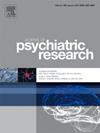A novel approach to investigate the mechanism of electroconvulsive therapy in the treatment of major depression disorder: Diffusion kurtosis imaging
IF 3.7
2区 医学
Q1 PSYCHIATRY
引用次数: 0
Abstract
Background
Major depression disorder (MDD) exhibits a high global incidence; however, its pathogenesis remains elusive. In this prospective study, we employed diffusion kurtosis imaging (DKI) to investigate changes in brain function among patients with MDD both pre- and post-electroconvulsive therapy (ECT).
Methods
We divided a sample of 22 MDD patients into ECT group, which received six treatments over a span of two weeks, and control group (n = 12). DKI scanning was performed before and after treatment. The Hamilton Depression Rating Scale (HAMD) and Life Satisfaction Rating Scale (LSRS) were administered to assess depressive symptoms at baseline, on the 14th day, and at month three.
Results
Significant differences were found between group, time and time × group in terms of HAMD score and LSRS score. In the ECT group compared to pre- ECT measurement, changes in mean diffusivity (MD), fractional Anisotropy (FA), mean kurtosis (MK), radial kurtosis (RK), FA of kurtosis (KA), and anxia kurtosis (AK) value were detected in specific regions such as the frontal, temporal lobe, and hippocampus. In the control group only MD and RK value increased in a limited number of area.
Conclusions
ECT holds the potential to elicit neuroplasticity in the brain, facilitating rapid structural modifications and amelioration of depressive symptoms in patients with MDD.
研究电休克疗法治疗重度抑郁症机制的新方法:扩散峰度成像
背景:重度抑郁障碍(MDD)在全球的发病率很高;然而,其发病机制仍然难以捉摸。在这项前瞻性研究中,我们采用弥散峰度成像(DKI)研究了电休克疗法(ECT)前后重度抑郁症患者大脑功能的变化:我们将 22 名 MDD 患者分为电休克治疗组(两周内接受六次治疗)和对照组(12 人)。在治疗前后进行 DKI 扫描。汉密尔顿抑郁量表(HAMD)和生活满意度量表(LSRS)用于评估基线、第14天和第3个月时的抑郁症状:在 HAMD 评分和 LSRS 评分方面,发现组间、时间间和时间×组间存在显著差异。与电痉挛治疗前的测量结果相比,电痉挛治疗组的额叶、颞叶和海马等特定区域的平均弥散度(MD)、分数各向异性(FA)、平均峰度(MK)、径向峰度(RK)、峰度的FA(KA)和缺失峰度(AK)值均发生了变化。在对照组中,只有少数区域的 MD 和 RK 值有所增加:结论:电痉挛疗法具有激发大脑神经可塑性的潜力,有助于快速改变 MDD 患者的结构并改善其抑郁症状。
本文章由计算机程序翻译,如有差异,请以英文原文为准。
求助全文
约1分钟内获得全文
求助全文
来源期刊

Journal of psychiatric research
医学-精神病学
CiteScore
7.30
自引率
2.10%
发文量
622
审稿时长
130 days
期刊介绍:
Founded in 1961 to report on the latest work in psychiatry and cognate disciplines, the Journal of Psychiatric Research is dedicated to innovative and timely studies of four important areas of research:
(1) clinical studies of all disciplines relating to psychiatric illness, as well as normal human behaviour, including biochemical, physiological, genetic, environmental, social, psychological and epidemiological factors;
(2) basic studies pertaining to psychiatry in such fields as neuropsychopharmacology, neuroendocrinology, electrophysiology, genetics, experimental psychology and epidemiology;
(3) the growing application of clinical laboratory techniques in psychiatry, including imagery and spectroscopy of the brain, molecular biology and computer sciences;
 求助内容:
求助内容: 应助结果提醒方式:
应助结果提醒方式:


